| Hamden Fire Retirees Association, Inc. |
 |
| January 15, 1929 |
|
|
FRIDAY, JANUARY 12, 2018
Website is updated every Friday - Important interim updates will be posted when necessary
Next regular update is Friday, January 19th.
|
 |
| CLICK to monitor HFD radio |
|
|
__________________________________________________________________________________________________________
|
|
| Hamden Fire Retirees Assn.
Winter Meeting
Next Thursday, January 18th at 9:00 AM
Hamden Elks' Lodge, 175 School Street
FREE continental breakfast of Danish, donuts, juices, milk and coffee will be served.
AGENDA
- Treasurer’s Report for 2017.
- Report on sales of Hamden Firefighting.
- Report on 501(c)(7) non-profit status with the IRS, which would eliminate the association’s annual $250 corporate fee to Connecticut.
- Report on Chief Berardesca’s announcement regarding the future of the old schoolhouse.
- Members who have yet to pay their 2018 dues may pay at the meeting. 2018 dues cards will be distributed.
- Anything for the Good of the Association.
- Copies of Hamden Firefighting will be available - $19.00 – profits to benefit the HFRA.
If you can't attend and have yet to pay, please send your $15 check made out to "HFRA" to: HFRA, P.O. Box 185605, Hamden, CT 06518
HOPE TO SEE YOU THERE!
|
|
__________________________________________________________________________________________________________
|
The First "Big One"
Sunday, January 13, 1918
Hamden Plains Methodist Church
Dixwell Avenue and Church Street
|
One hundred years ago this week, on Sunday, January 13, 1918, fire destroyed the Hamden Plains Methodist Church at the corner of Dixwell Avenue and Church Street. It is the earliest Hamden fire for which photographs are known to exist. Below is an account of that fire that was published on this website eight years ago.
|
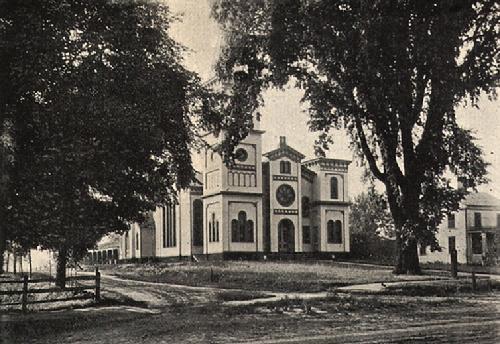 |
| From 1898 Booklet |
|
In late 1984, The Hamden Chronicle ran a story about some of Hamden's great fires. At the end of the article, Editor Steve McCarthy inserted a paragraph asking readers with photos, news articles or related memorabilia about old Hamden fires to contact the training division at fire headquarters.
A few days later a letter was received from Lester Hintz, a lifelong parishioner at the Hamden Plains Methodist Church. Mr. Hintz's letter included a handwritten account (printed below) of Hamden's first notable fire of the 20th century, written many years earlier by an eyewitness whose identity is not given.
The photos on this page, courtesy of the Hamden Historical Society, were scanned from the 1920 dedication program for the new church, which still stands today at Dixwell Avenue and Church Street. They are the oldest known photos of a Hamden fire.
|
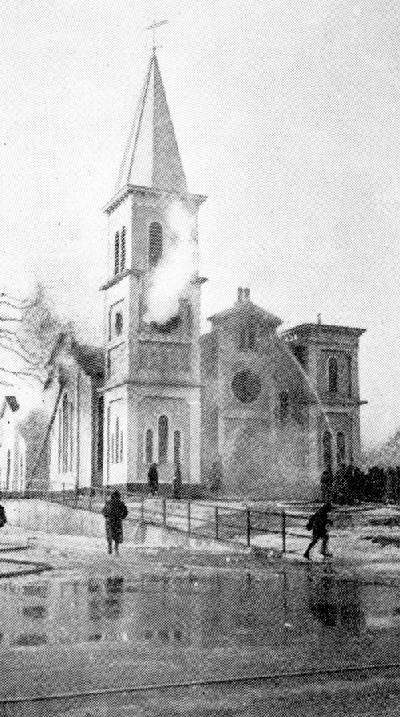 |
| January 13, 1918 |
|
From a Handwritten Account by an Unidentified Eyewitness:
On January 13, 1918 the church building caught fire. It started in the library from a defective chimney where the mortar had crumbled away.
In those days church services were from 10:30 to 12 noon and Sunday School from 12:00 to 1:00 p.m. The fire started at about 1:30 p.m. The sexton, John Maute, lived on Beacon Street. He saw the smoke and rushed back to the church and rang the bell to give an alarm.
He was a veteran of the Civil War, and being true to the tradition of a soldier, rushed into the Sunday School room and rescued a silk American flag which was a gift from the Ladies Aid Society to the Sunday School. The flames soon got up into a blind attic underneath a tin roof. A strong southwest wind pushed the fire from the rear of the church across to the front of Dixwell Avenue.
Three volunteer fire companies from Hamden and one paid company from New Haven fought the fire and kept it from completely destroying the building. While the firemen were trying to get at the fire in the upper part of the church, people were taking out hymnals, library books, chairs and everything that was movable.
|
The pulpit had a gaslight on it, and the gas pipe went through the pulpit, so it could not be carried out. The wind that day was averaging between 19 and 22 miles per hour, with gusts up to 30. The temperature was 13 degrees above zero. These readings were all taken at the Weather Bureau in New Haven at the post office. Out here in Hamden the temperature is about 5 degrees lower than in New Haven and the wind velocity is higher.
Fortunately, there were no injuries to firemen, but some were overcome with smoke. Some of them had on ordinary overcoats which soon got wet and then froze. They were so stiff they had to be pulled off while the firemen struggled to get out. It was nearly dark when the firemen began to pick up their equipment and leave.
____________
After the fire, the Humphrey Volunteer Fire Association offered the use of its meeting room for church services, as did the Whitneyville Congregational Church.
According to the 1920 dedication program of the new church, "When it was discovered, in the early afternoon, the fire had gained fearful headway; and, upon arrival, the Humphrey, Whitneyville, and Highwood volunteer fire companies, reinforced by an engine from the New Haven Fire Department, a fight with this relentless foe and modern fire apparatus began in earnest, until nearly dark."
Whitneyville would have responded with motorized apparatus. The engine company from New Haven was most likely Engine 6 out of Dixwell Avenue. New Haven still had some horse drawn apparatus in 1918, but Engine 6 was motorized.
The Hamden Plains Methodist Church fire was probably the driving force behind the purchases of two 1918 Stewart chemical trucks for the Highwood and Mt. Carmel fire companies, and a 1919 Seagrave 750 GPM pumper, affectionately dubbed "Big Bertha," for Humphrey.
Posted 1/13/11
|
__________________________________________________________________________________________________________
|
Unfortunately, these "half-tone" images of the fire, made up of hundreds of tiny dots, are not the best quality. Yet long before there was an HFRA, one of our present members recalled seeing original, framed, high quality prints of these photos hanging on the wall of another Hamden church. But he could not recall the exact location. Does anyone know?
|
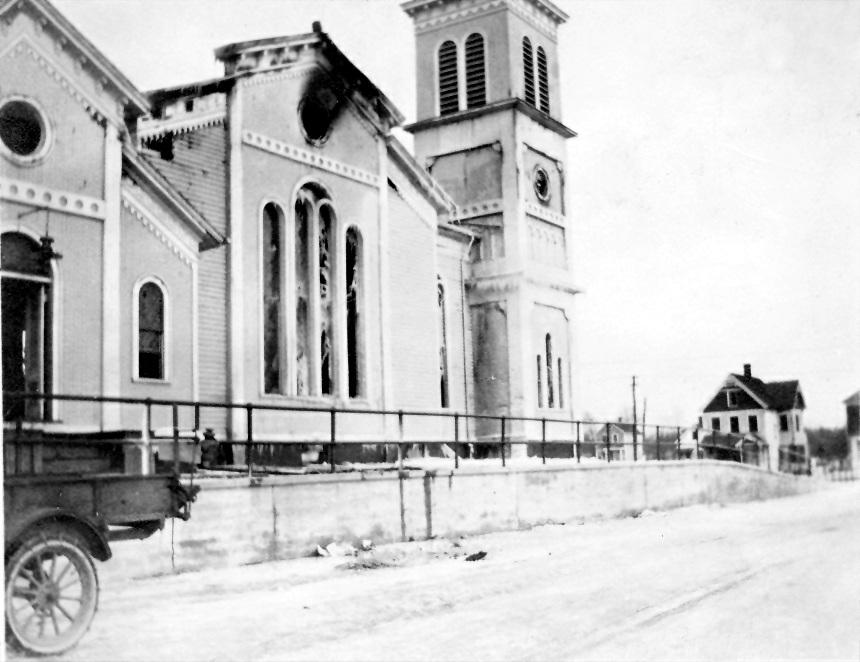 |
| Aftermath |
|
|
 |
| Out of the ashes - Rebuilt in 1920 |
|
|
__________________________________________________________________________________________________________
|
50 YEARS AGO!
Fleming Co., Broadway at Ives Street
Friday, January 12, 1968
_______
|
Major fire launches a transitional year for the Hamden Fire Department
(Originally published on the Local 2687 website in January 2008)
|
 |
| Jean Law |
|
It has been forty years, but Jean Law will never forget the early morning hours of Friday, January 12, 1968, when she was wakened by loud voices outside her home at 203 South New Road. Jean didn’t see any people when she peeked out of her front picture window, only a huge orange glow reflecting on the houses across the street. But it was a different story when she looked out a rear window, through the leaf-bare trees across Mill River to Broadway.
Now, well into her eighties*, Jean easily recalls how she sat by the window that morning witnessing one of the most spectacular blazes in Hamden history.
-----
*Ed. Note: Jean Law passed away in August 2016 at the age of 96.
|
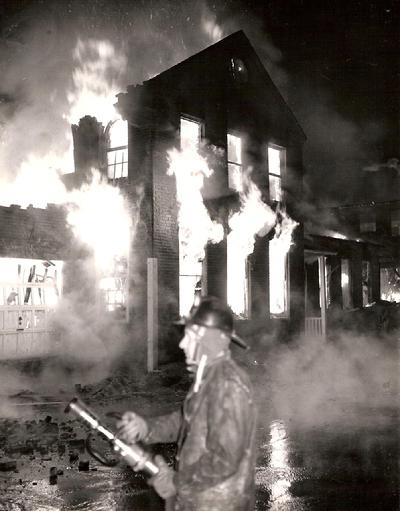 |
| Photo by John Mongillo Jr. |
|
According to newspaper accounts, as well as recollections from firefighters who were there, a truck driver heading north on Ridge Road at about 3:45 that morning noticed a glow in the sky. Wanting to check it out, the man drove his truck down Broadway, following the glow to the George W. Fleming Co., where he found the south end of the rambling 133-year old brick building fully involved. He was the only spectator.
The truck driver raced up Ives to Whitney and pulled onto the ramp at Station 5. In those somewhat simpler times Hamden firehouses were always unlocked, so he had no trouble getting inside. He ran to the watch desk and picked up the “house phone,” which was basically a P.A. system to all fire stations, and shouted, “Fire! Fire!” over the loud speakers of every fire station in town.
Firefighters Mario “Bucky” Serafino and Gerry Wolf were asleep upstairs at Station 5. When wakened by their visitor, Serafino and Wolf were able to relay further details to dispatcher Russ Norman over the inside PBX line. Russ immediately dispatched Bucky and Gerry on Engine 5, as well as Engine 4 and Rescue 2 out of Station 4 and Ladder 1 out of Station 2. The volunteers of Co. 5 were then "toned out."
The New Haven Register reported, “When the first company reached the scene, the fire was surging through the roof and lashing along the sides of the structure.” Fire Chief V. Paul Leddy had no trouble seeing the conflagration from his Cumpstone Drive home. He immediately ordered a second alarm, which brought Engine 2 from Station 2, Engine 3 and Rescue 1 from old Station 3 on Putnam Avenue, as well as additional volunteer companies 7 and 9. North Haven dispatched a pumper from their West Ridge station.
|
 |
| At the turn of the 20th century |
|
According to an account in The Hamden Chronicle, the building had been erected in 1835 by James Ives as the Mt. Carmel Brass Works. From the 1880s until the early 20th century, it was occupied by W. Woodruff and Sons, manufacturer of some of the finest carriage hardware in the United States. In the early 19-teens, the building was also served as the meeting place and quarters for the Mt. Carmel Volunteer Fire Co.
At the time of the fire, the principal occupant of the building was the George W. Fleming Co., manufacturers of cutlery (see related "cutlery" item below). However, the manufacturing end of the business had moved to Wallingford only a few months earlier. By the time of the fire, the Fleming Co. portion of the building was being used only as a warehouse for their products. The Ives Street end of the building complex previously housed the Sterling Beverage Co. By January 1968, Sterling Beverage had rented their part of the building to the Cott Beverage Co. of New Haven for storage.
The building was heavily involved when the first apparatus arrived. The main objective was saving the undamaged portions of the structure, as well as protecting the adjacent exposures on Broadway. The home of the Rexford Barnes family, right next door at 40 Broadway, was only about twenty feet from the southern end of the building.
It was a bitter cold night, with temperatures hovering around zero. Parallel 2½” water supply lines were pumped from a 3-way hydrant on Ives Street near New Rd. Two ancient 2-way hydrants were located further down Broadway at #58 and #100. At least one of them was frozen. The Register reported, “Hose lines were stretched to nearby Mill River in order to pump water, but Chief [V. Paul] Leddy noted that firemen had some difficulty with pumps freezing intermittently.”
Retired Battalion Chief Thomas Doherty, a seven-year veteran at the time, recalls having been recently transferred from Headquarters (now Station 4) to Station 2, where he was assigned to drive Ladder 1, the 1958 Maxim 75-foot aerial ladder truck. When the alarm sounded, Firefighters Doherty and Bill Mulcahy responded from Station 2 in the open-cab truck in sub-zero temperatures.
Today, Chief Doherty recalls that by the time they got to the fire he and Mulcahy were both frozen stiff. They were ordered to set up the aerial ladder pipe to protect the Ives Street end of the building, which was saved and remains standing to this day. Despite the intense radiant heat and flying brands, efforts to protect the Barnes’ home and the other homes immediately south of the building were successful, as well.
Firefighters Ed Doiron and Mickey Cantarella were on Engine 6 at 21 Merritt Street. The only paid company left in service, Engine 6 relocated to Station 3 on Putnam Avenue to cover the town with Volunteer Co. 8. [NOTE: No career firefighters were assigned to Co. 9 until the “new” Station 9 was opened in December 1968.]
|
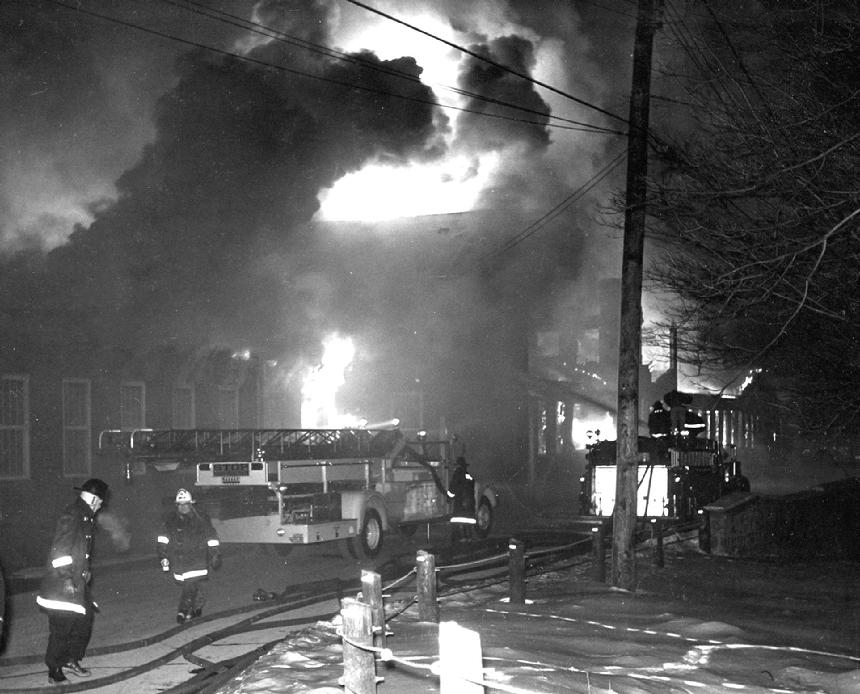 |
| Photo by John Mongillo Jr. |
|
|
 |
| Ff. Charlie Carlson, Lt. Ken Harrington and Ff. Joe Shields take a break after the fire was under control. |
|
The shift commander was Deputy Chief Joseph Hromadka (above in white helmet), who told the Register that the blaze was “one of the largest that he could remember” in his 32 years on the Department. Chief Hromadka was one of the original two shift commanders to be appointed from among the ranks of the career firefighters when the Department was reorganized with paid officers in 1942.
__________
Having joined Volunteer Co. 5 in October 1966, I did not yet have a “Plectron” radio, the dinosaur plug-in ancestor of today’s pagers. Hearing news accounts of the fire on my car radio after two morning classes at SCSC, I finally arrived at the scene well after the fire had been knocked down. But I was just in time to help roll up the hundreds of feet of 2½ that had spaghettied all over Broadway.
As I recall, the firefighters on Engine 5 that day shift were Fred Fletcher and Dave Howe. I would work with Dave twelve years later at Mt. Carmel. Once all the hose was rolled up, fellow Co. 5 volunteer Bill Kelly and I rode the tailboard of Engine 5 to Station 2 to help change hose. This was my first ride on a tailboard.
When we arrived at 2’s, the “paid guys” were only too happy to let Bill and me assist in repacking Engine 5 with 1,000 feet of fresh 2½. We were eager to pitch in and learn how to keep the end folds even with something called a "Flying Dutchman." This was still a couple of years before all hose beds were split into separate bays of 2½” and 3” hose for parallel lays, and seventeen years before the introduction of large diameter hose.
|
 |
| Photo by John Mongillo Jr. |
|
Some modern historians say that 1968 was a transitional year for America. On a somewhat smaller scale, 1968 was also a transitional year for the Hamden Fire Department.
At the time of the Fleming Company fire in January, Engine 1 was a 1938 Seagrave 600 g.p.m. pumper at Station 2 – the Department’s spare.
Engine 2 was a 1959 Maxim “cab-forward” 750 g.p.m. pumper.
Engine 3 was a 1954 Maxim 750 g.p.m. pumper.
Engine 4 was a 1965 Mack 750 g.p.m. pumper, the Department’s first commercial-chassis apparatus since the Diamond-T engines of the early 1940s.
And Engines 5 & 6 were identical 1951 and 1952 Maxim 750 g.p.m. pumpers.
In 1968, Hamden’s first paid Fire Marshal, Al Purce, and the first Superintendent of Alarms & Apparatus, Clem Wetmore, were both nearing retirement but were still on the job.
The Department’s only ladder truck was the aforementioned 1958 75-foot Maxim “Junior” Aerial at Station 2. The rescue units – this was three years before Hamden’s first group of EMTs – were 1958 and 1960 International Travelalls, similar to today’s Chevy Suburbans.
By the end of 1968, the Town had purchased two new identical Maxim S-model 1000 GPM pumpers that were placed in service at Stations 3 and 4. The 1965 Mack became Engine 2. The 1959 Maxim cab-forward became Engine 1, and the 1938 Seagrave "canopy-cab" was sold, regrettably, to a party who scrapped it for the value of its brass pump.
Hamden's first new fire station since the Hamden Fire Department was created under the Connecticut General Statutes in 1925 was dedicated on December 8, 1968. Station 9 opened with one paid man on each of the three platoons. "Paid" Engine 9 was the 1951 Maxim pumper.
By the end of 1968, Marshal Purce and Supt. Wetmore had retired. Their vacancies were filled by Captain Bob “Bubby” O’Donnell and Asst. Supt. Richard Lostritto, respectively.
Also in 1968, the Town and the Hamden Paid Firemen’s Sick Benefit Association, which had become the bargaining unit for non-management fire personnel, agreed on the implementation of a 42-hour workweek to commence on October 6, 1970. Since 1951, line personnel had worked an average of 56 hours a week (four days on, two days off, etc.).
Two years later, old Station 3 on Putnam Avenue and Station 6 on Merritt Street were both closed when “new” Station 3 opened at Hartford Turnpike and Ridge Road in September of 1970. The new station housed Engine 3, Engine 6, Rescue 1, the Deputy Chief (shift commander), and a second truck company, Ladder 2, a new 1970 Maxim 100-foot aerial truck.
When they were delivered in the late 1950s, the 1958 Maxim aerial ladder truck and the 1959 Maxim “cab-forward” pumper were both painted white, the Hamden Board of Fire Commissioners being somewhat enamored of the New Haven "look." But in 1971, five years after a charter revision put the fire chief squarely in charge of the Department, the 1958 Maxim ladder and the 1959 Maxim pumper were repainted red. The truck also received a new convertible-type soft top that kept the rain off your head, but did little to abate the frigid winter temperatures.
The '58 Maxim aerial ladder truck remained at Station 2 until April 9, 1976, when it was transferred to Station 5’s new annex built the previous year. In November of 1984 the truck was transferred once again, this time to Station 9. The following year, it was removed from service and redesignated "Truck 2." The 1970 100-foot aerial ladder truck, now designated “Truck 1,” became the Department’s only truck company. Both trucks were retired in early 1990.
The two white International rescue trucks were removed from service in 1971 when the Department’s first “modular” unit, Rescue 1, was assigned to Station 4. The ornate gold leafing that decorated the new bright red 1971 Ford cab and box resulted in the somewhat whimsical, if not affectionate nickname, “the Circus Wagon.”
For the next several years, Engine 2 handled all rescue calls in the south end of Hamden. With the introduction of paramedic service, Rescue 2, on a 1975 Ford chassis, went in service at Station 2 on April 9, 1976.
Engine Co. 6 at new Station 3 was deactivated in 1974. The 1959 Maxim “cab-forward,” which had been Engine 1 from 1968 to 1974, was moved to Station 3 and became Engine 6, the Department’s permanent spare pumper. In 1981, it was repowered with a new diesel engine and remained in reserve until the early 1990s.
Dave Johnson
Captain
Hamden Fire Department (Ret.)
January 8, 2008
Originally posted on the Local 2687 website - 1/12/08
|
CLICK on any of the nine photos below to enlarge them.
(All nine photos by John Mongillo Jr.)
|
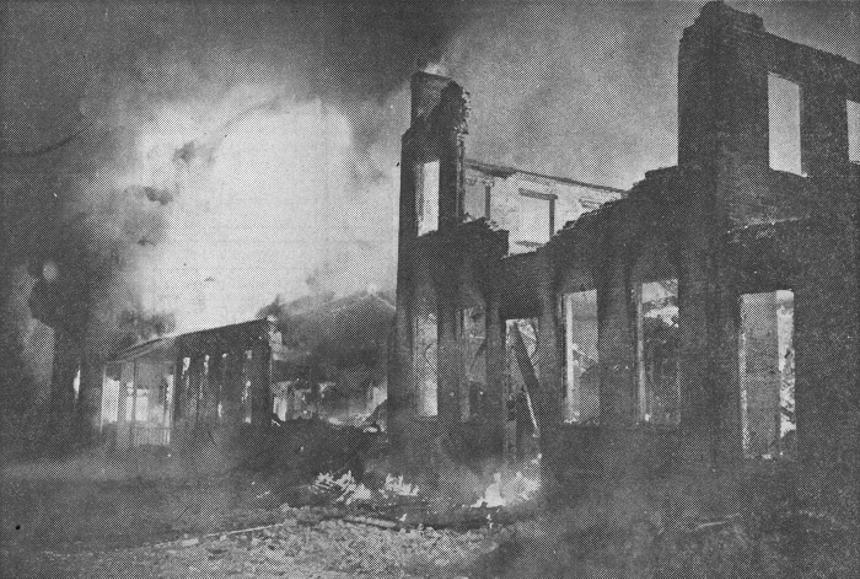 |
| © 1968 - The New Haven Register |
|
|
Tom Doherty was on Ladder One on the night of the Fleming Co. fire. After being relieved by the day shift, Tom took a dozen color slides of the aftermath of the fire - shown below.
Each of the photos below may be enlarged by clicking on them.
|
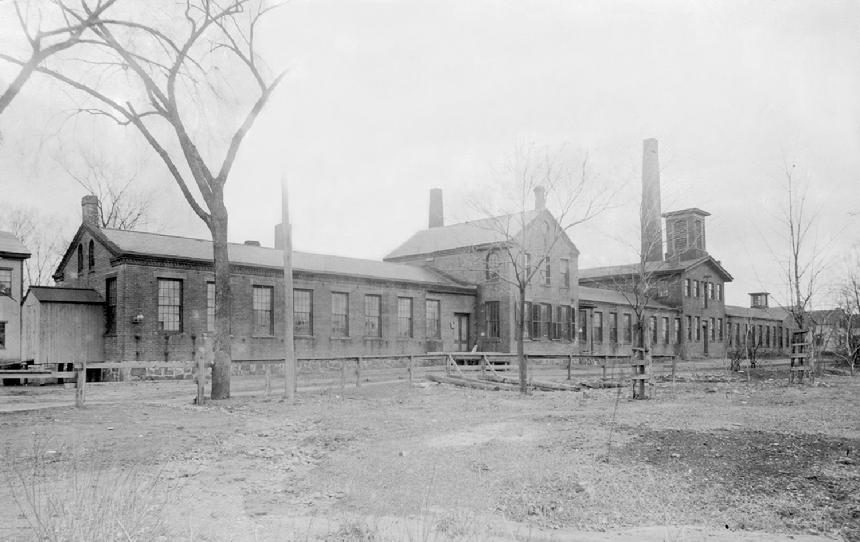 |
| Woodfruff Factory c. 1890 - Hamden Historical Society (CLICK to enlarge) |
|
|
According to an account in The Hamden Chronicle, the building was erected in 1835 by James Ives as the Mt. Carmel Brass Works. It was later occupied by W. Woodruff and Sons, which manufactured various hardware items during the latter part of the 19th century and the early half of the 20th.
|
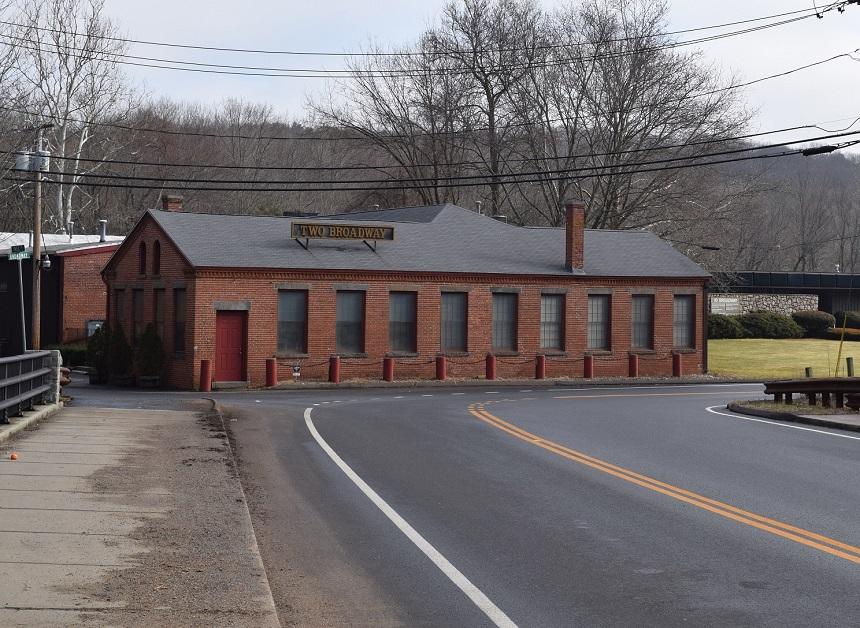 |
| Today |
|
|
Hundreds of these cutlery sets were being warehoused at the Fleming Co. the night of the fire. After all the hose was taken up, some of these souvenirs found their way out of the rubble and back at the fire stations. This resulted in a sternly worded admonition from Chief Leddy that all cutlery liberated from the Fleming Co. shall be returned to the watch desk at Headquarters - "no questions asked." This particular set, in pristine condition, was donated by an unnamed 1968 "paid guy," who apparently never read the memo.
Posted 1/20/12
|
__________________________________________________________________________________________________________
|
10 YEARS AGO!
28 Turnor Avenue
Wednesday, January 9, 2008
_______
2-Alarm fire claims life of grandmother
|
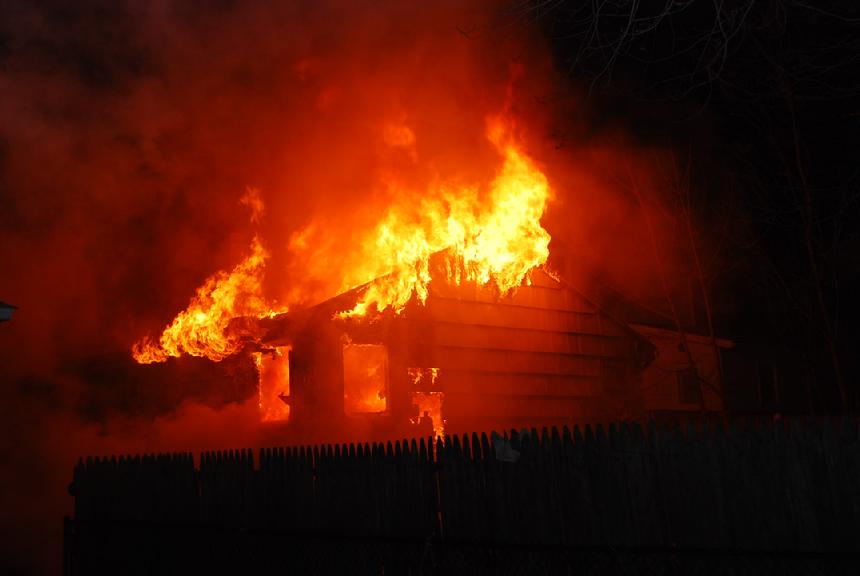 |
| Photo by Bob Martens |
|
|
Retired West Haven firefighter and former New Haven Register photo contributor Bob Martens took these photos of a fatal fire ten years ago on Turnor Avenue, which runs one-way south from Putnam Avenue to Augur Street. An 86-year old grandmother perished and her 31-year old grandson was badly burned in the blaze, the source of which was not known at the time these photos were first published.
Posted 1/12/18
|
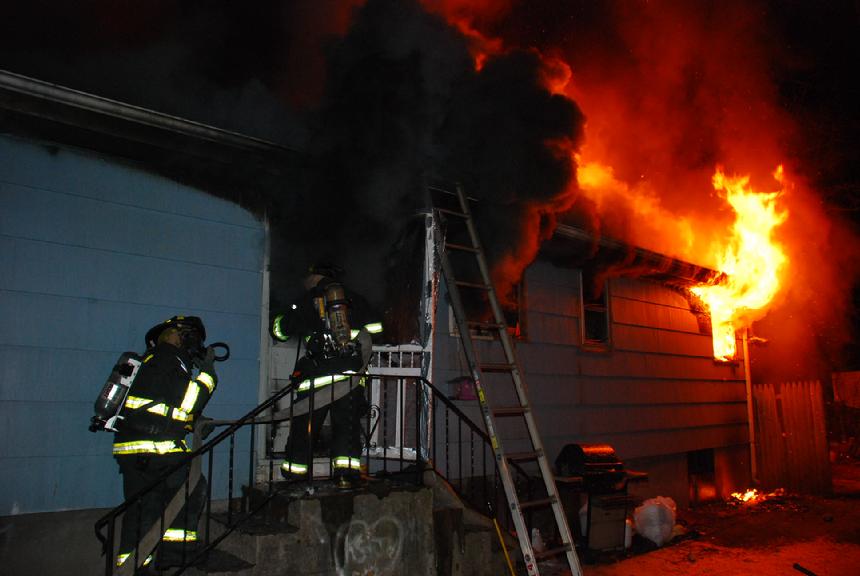 |
| Photo by Bob Martens |
|
|
The above photo by Bob Martens appeared on the front page of the January 10, 2008 New Haven Register with the following caption, "Hamden firefighters battle the two-alarm fire Wednesday on Turnor Avenue that took the life of an 86-year old woman. Her 31-year old grandson was critically injured in the blaze. Attempts to rescue the woman failed as extreme heat drove back firefighters."
|
 |
| Photo by Bob Martens |
|
|
Website thanks to Bob Martens for providing these sobering images
of the January 9, 2008 fatal fire on Turnor Avenue.
Posted 1/12/18
|
__________________________________________________________________________________________________________
|
|
NEVER FORGET!
We will always remember our brother firefighters who made the supreme sacrifice, and the thousands of other innocent victims who lost their lives on September 11, 2001.
Always keep them, their families and the FDNY in your thoughts and prayers.
|
__________________________________________________________________________________________________________
|
|